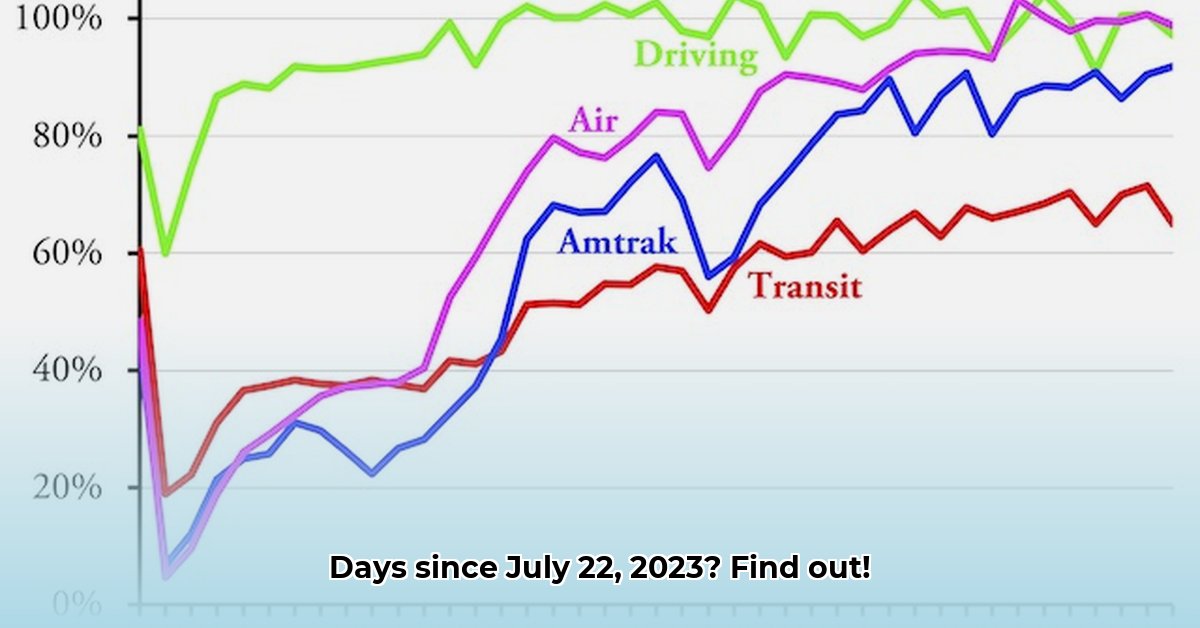
Calculating the Elapsed Days: A Deep Dive into Timekeeping
Have you ever wondered how many days have passed since a specific date? Let's consider July 22nd, 2023. While seemingly straightforward, accurately calculating the elapsed days reveals fascinating insights into the complexities of our calendar system – the Gregorian calendar. This exploration goes beyond simple counting, delving into the historical context, practical applications, and inherent limitations of our timekeeping methods.
The Gregorian Calendar: A Brief History
The Gregorian calendar, our current standard, isn't ancient; it's a refined version of the Julian calendar, introduced by Pope Gregory XIII in 1582. The Julian calendar, while a significant advancement in its time, contained a slight miscalculation of the solar year's length. This inaccuracy accumulated over centuries, necessitating the Gregorian reform. Key changes included dropping ten days from October 1582 and adjusting the leap year rules to improve accuracy. Even with these improvements, minor discrepancies remain. Understanding this history is crucial for appreciating the complexities of date calculations.
Simple Calculation Methods and Their Limitations
Determining the days since July 22nd, 2023, is easily done using online date calculators (e.g., timeanddate.com). However, these tools often obscure the underlying process. A manual calculation, while more labor-intensive, offers a deeper understanding. For example, to calculate the days between July 22nd, 2023, and March 1st, 2024, we'd first determine the remaining days in July (9), then add the days in August through December (153), and finally, add the days in January and February of 2024 (61, accounting for the leap year). This sums to 223 days. But this simplicity masks the complexities of leap year rules and the inherent inaccuracies in the Gregorian calendar itself.
But how accurate is this seemingly simple calculation? How do leap years factor into the equation? Isn't there a deeper understanding to be gained?
The Significance of Leap Years
The accuracy of our date calculations hinges on leap years. The approximately 365.25-day solar year necessitates adding an extra day (February 29th) every four years. However, the rule isn't absolute; century years (like 1900) are not leap years unless they are also divisible by 400 (like 2000). These subtleties significantly impact long-term calculations. Ignoring these nuances can lead to substantial errors when calculating the number of days over extended periods. Precise calculation, therefore, demands a thorough understanding of leap year rules.
Real-World Applications of Precise Date Calculation
The ability to accurately calculate the number of days since a specific date has far-reaching applications. Financial reporting, project management, software development, and historical research all rely on precise date calculations. Businesses use these calculations for scheduling, invoicing, and forecasting. Software developers depend on accurate date functions for their applications' proper functionality. Historians use precise dating to contextualize events within their chronological sequence. The seemingly simple act of counting days underpins many critical processes.
What other critical applications rely on the accurate calculation of days between dates? How do these calculations impact our everyday lives?
The Imperfect Nature of the Gregorian Calendar
While the Gregorian calendar is a vast improvement over its predecessors, it does not perfectly align with the solar year. Minute discrepancies remain, implying the possibility of future refinements. This subtle inaccuracy emphasizes the ongoing effort to achieve a perfect synchronization between our calendar and Earth's orbital mechanics. Therefore, while our calculation of the days since July 22nd, 2023, is highly accurate, it's important to acknowledge the limitations of the underlying system.
Beyond the Gregorian: Exploring Alternative Calendar Systems
It's crucial to remember that the Gregorian calendar isn't universal. Many cultures throughout history and across the globe utilize alternative calendar systems, including lunar calendars that track the moon's cycles and solar calendars with varying structures and leap year rules. The Islamic calendar, for example, doesn't align with the Gregorian system, making direct date comparisons difficult. This diversity underscores the cultural and historical influences shaping our perception of time.
Efficiently Calculating Dates Across Calendar Systems
The previous section highlighted the importance of understanding the Gregorian calendar's intricacies for accurately calculating days. However, real-world applications often require navigating different calendar systems. Let’s explore these challenges and effective strategies for managing diverse timekeeping methods.
Navigating Diverse Calendar Systems
The prevalence of various calendar systems worldwide poses challenges for accurate cross-calendar date calculations. Each system has its unique rules, leap year conventions, and starting points, making direct translations complex. For example, converting dates between the Gregorian and Islamic calendars requires specialized algorithms due to their fundamentally different structures.
This complexity necessitates recognizing that a simple day count isn’t always sufficient when dealing with different calendar systems. What strategies can we employ to overcome this limitation?
Strategies for Accurate Cross-Calendar Calculations
Effective cross-calendar date calculations require a multi-pronged approach:
System Identification: First, precisely identify the calendar system for both the start and end dates. Any ambiguity can lead to significant errors.
Conversion Tools: Utilizing specialized conversion software or online tools designed for handling different calendar types greatly simplifies calculations. These tools often handle the complexities of leap years and variations in month lengths.
Algorithm Understanding: For a deeper understanding, acquiring familiarity with the algorithms underlying the conversions is beneficial. This allows for critical evaluation of the results from software or online tools, particularly when dealing with less common calendar systems.
Contextual Awareness: Understanding the cultural and historical contexts of the calendar systems in use improves accuracy and avoids misinterpretations.
How can we ensure precise date calculations when faced with varied calendar systems? What are the key steps for efficient conversion?
Conclusion: The Value of Precise Timekeeping
Accurately calculating the number of days since July 22nd, 2023, or any date across varying calendar systems, highlights the importance of precise timekeeping. This seemingly simple task reveals the intricate system of rules and conventions that govern our understanding of time, emphasizing the need for rigorous methods and contextual awareness when dealing with the complexities of various calendar systems. Whether for personal interest or professional applications, understanding these nuances ensures accurate and reliable date calculations.